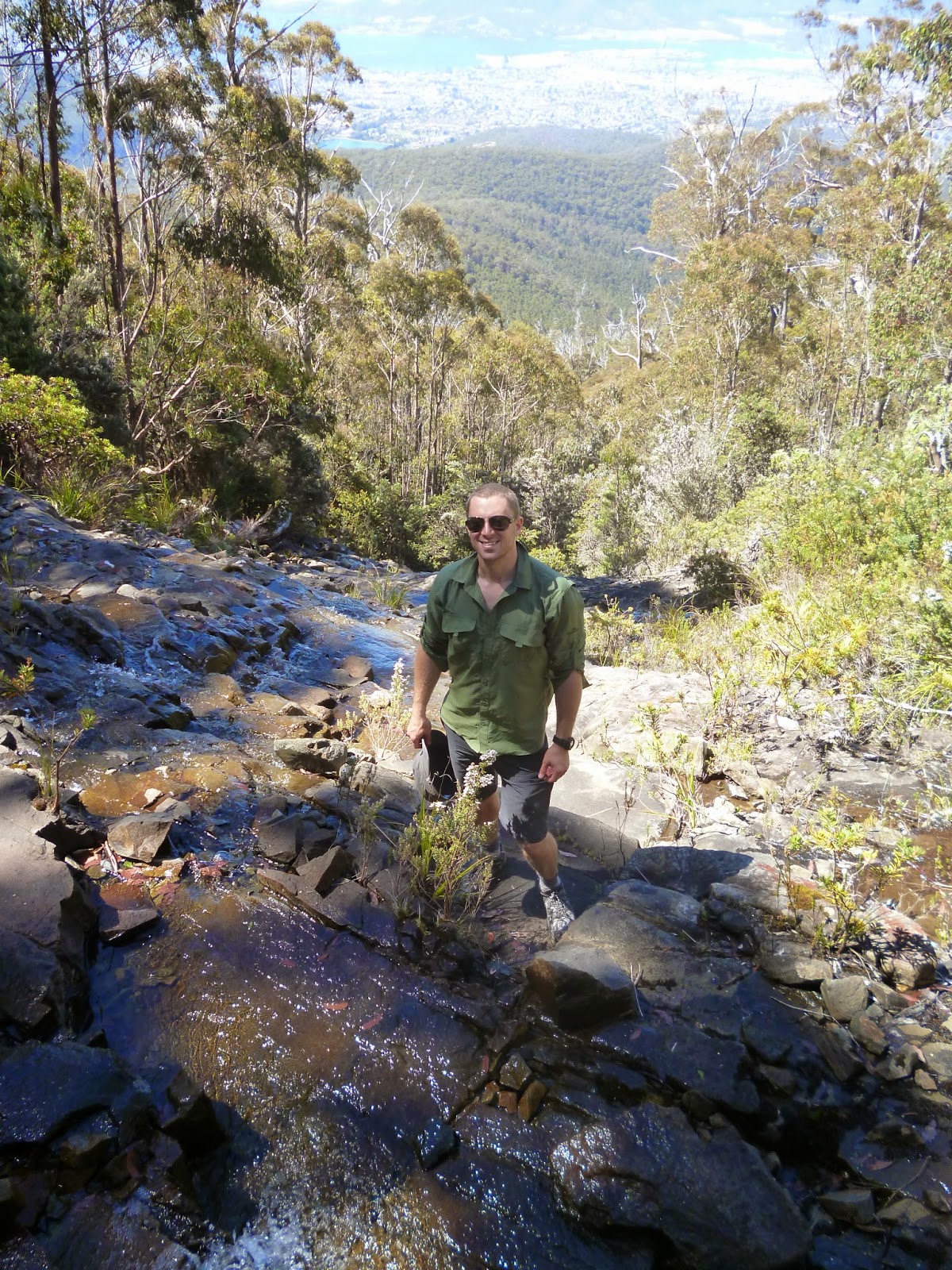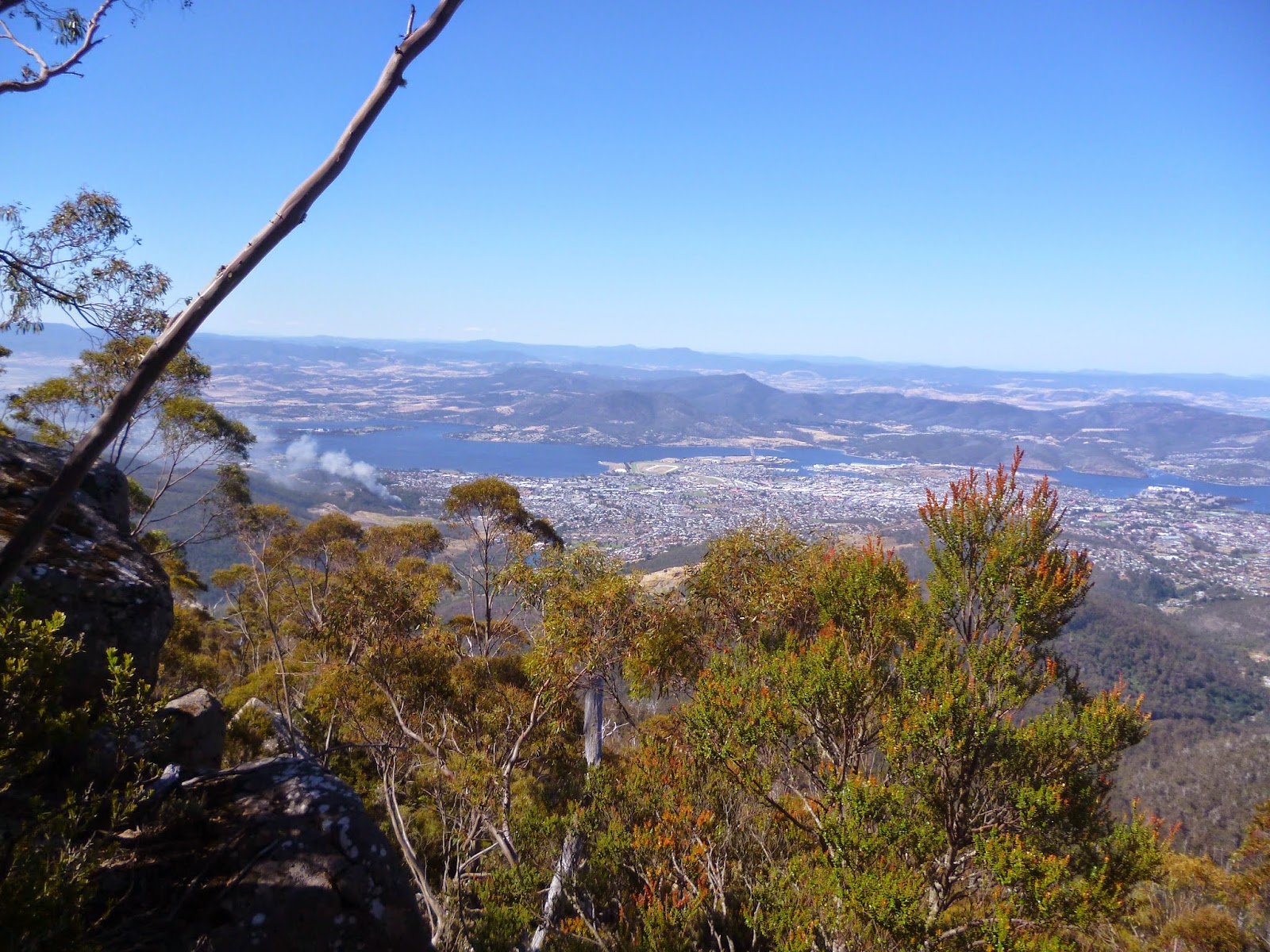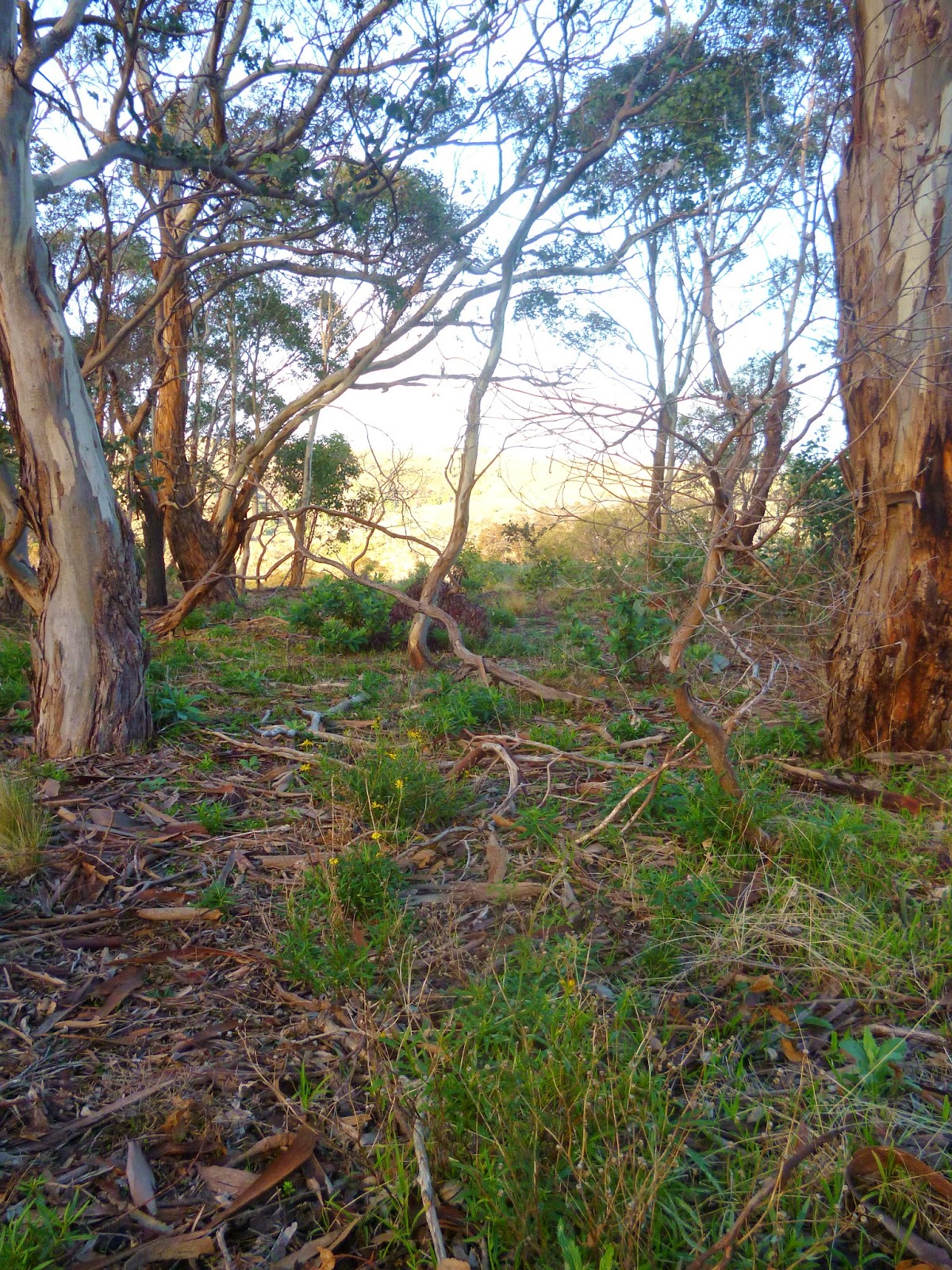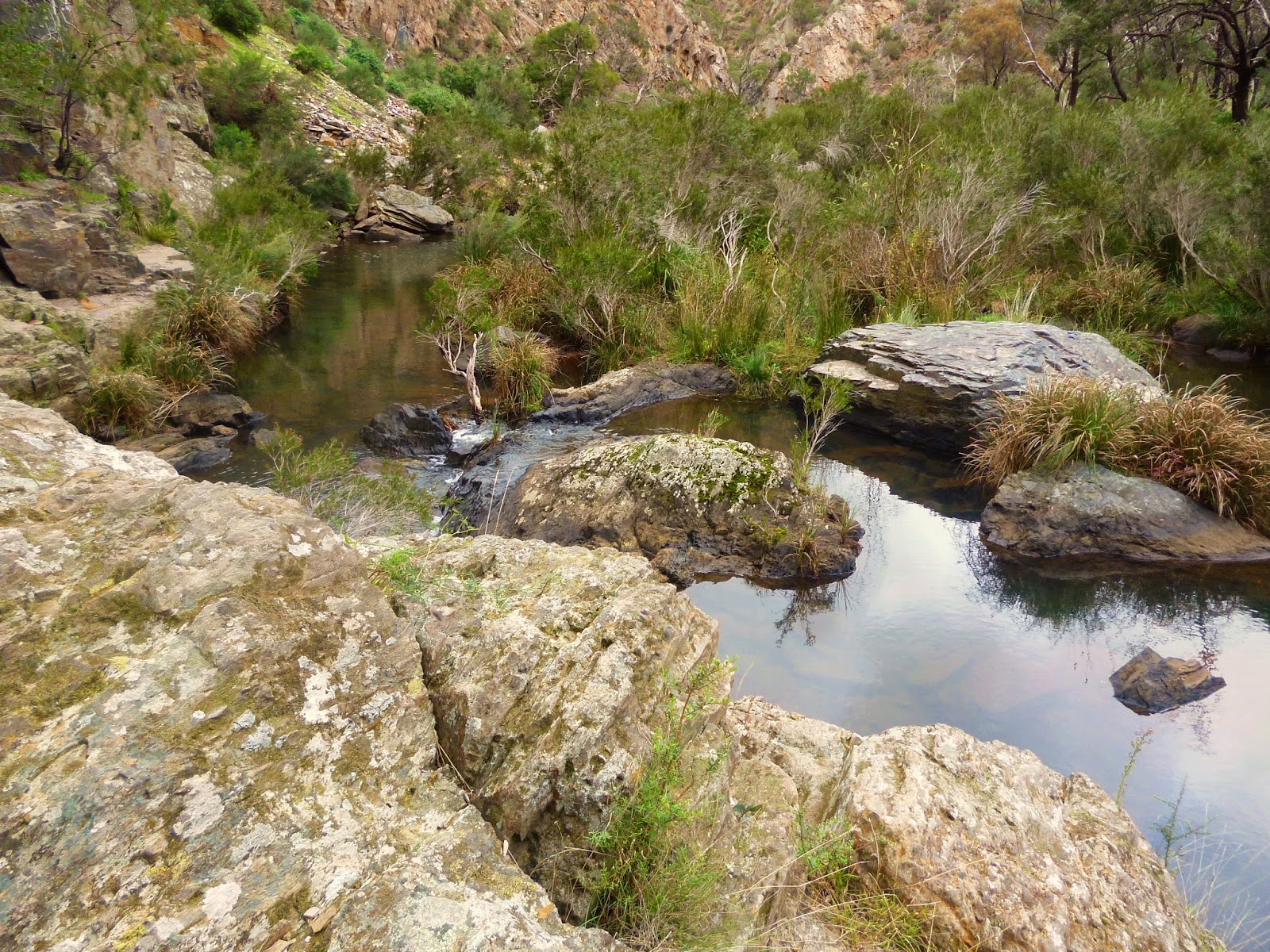With the recent defeat on the Mount Anne Circuit still fresh in our minds Pete, Tim and I were keen to get out and acquit ourselves by conquering another trail. Tim, as our Tasmanian guide, had recommended Mount Wellington which looms over Hobart and is only a short walk from his house. Our ears perked up as he told us about a little-known hike up to a place called the Lost World which Tim was interested to explore.
So the next morning we kitted out with an ample supply of snacks and water and set out on foot along the road towards Mount Wellington. It
was a stunning day, the sun was hot and there was barely a hint of cloud to be
seen. In fact, it was hard to believe that not more than 24 hours ago we had
been snowed-in on a mountain side and facing a serious possibility of hypothermia. That
was definitely not going to be a problem today.
We passed the Cascade Brewery along our route and Tim
explained that a large portion of the surrounding rain forest behind the brewery
was privately owned by them but they maintained it for public use. I pondered
this new information as we walked, and my thoughts went something like this: If Cascade supports forest conservation with
the profits they make from selling beer, then when I drink Cascade beer I am
supporting forest conservation. Forest conservation is saving the world and
therefore when I drink beer I am saving the world. This seemed like very sound logic to me and it
made me very happy indeed. In fact, I swore right then and there that I would do my bit
to support this worthy cause that very night.
The initial track began in a cool rain forest with the characteristic flora of moss and ferns. The grade was quite steep but the good conversation made it easy work.
After a while, the trail opened out into very different and dryer terrain dotted with smaller eucalypts . It was also becoming quite warm. At times we could now glimpse a view of Hobart and the great Derwent river below us.
We re-joined the trail further on and passed two other hikers, middle-aged gentlemen sporting
large cameras and large waists. We stopped for a short chat and they told us they were heading for the historic cabin that we had passed a good 40-minutes
earlier. They were under the impression they would find it imminently and none of us had the heart to disillusion
them. They continued on their merry way no doubt eagerly expecting to to find the cabin around the very next turn.
Not long after this encounter we veered off on another track
which Tim believed would take us in the direction of the Lost World. It soon
brought us to a small waterfall with a trickle of water running down. It looked
so inviting we just had to climb it!
The surface of the rock was treacherously slippery in places so we ascended cautiously. At least I did, it looked rather like Pete somehow fell up the waterfall in a series of rather terrifying and gravity-defying accidents but somehow he made it alive.

The view was beautiful and the water was cold and refreshing to splash on our faces. After a short rest there we made our way back down the waterfall to the path only to find that the path appeared to dead-end at the waterfall. There was no obvious way forward.

Clambering over boulders and logs we edged our way forward,
our eyes peeled for the painted marks. This part of the trek was a lot of fun
as we climbed our way up the side of the mountain on what looked like a giant
mound of boulders stacked one on top of another.
Along the side of the track we discovered the entrance to a cave. There were signs that either animals or people used it as there was a worn appearance to the ground outside. The opening was narrow and steep and the inside was pitch black so it was impossible to know how deep it was. We were all reluctant to venture in but curiosity got the better of me and with Tim holding on to my ankles I slid in head-first to take a look.
Even as my eyes adjusted slowly to the dim interior it was
still too dark to make out any hand or footholds so Tim handed me the camera to
take some photos with the flash on. In the brief flashes from the camera I
could see that there was a sharp drop of about 5-6 feet in front of me with the
cave continuing on down at an angle until it was beyond view. I clearly couldn't
go any further with only my head to break my fall so I gracefully wriggled my
way arse-up out of the cave. Reviewing the photos on the camera as we walked on
we discussed the possibility of returning one day, better equipped to explore
how far this cave went.
The trail continued steeply ascending Mount Wellington until
we came up over the edge of a boulder to find ourselves on a sort of plateau
beneath a semi-circle of sheer cliff. We had found the Lost World!
For some reason I didn't take many photos in the Lost World,
maybe it’s for the best, because the photos don’t do it justice. Perhaps it was
also because I was so busy watching my footing. The entire area consisted of
fallen boulders of gargantuan size with some truly spectacular chasms between
them. One chasm I peered into appeared 20 meters deep and had ferns growing in
its depths. It was quite magical really, as if you could
imagine a whole miniature fairy kingdom living down there.
Although we searched everywhere, there was no marking of the trail to be found and we were beginning to think the only way out was to scale the sheer cliffs. We headed off in different directions to explore our options. Tim and Pete went ahead, and I responded to the call of nature and went off to find a decent toilet spot. There was to be no burying of anything up here because it was all rock and so I was forced care of business in the only suitable place available. I am not sure the residents of the fairy kingdom would have appreciated my choice very much and I imagined their joyful singing abruptly replaced by cries of horror and pleas of "Won't someone please think of the children?!". Fanciful you may think, but such is the effect of being in the Lost World.
By now, Pete and Tim were out of sight and I began the
arduous process of navigating a route across the giant boulders and around the chasms.
I saw Pete ahead as he made an enormous leap between two boulders and figured I
would head in that direction. When I got there I realised it was at least a
three meter gap to the other boulder with a 15 meter drop straight down. It would require a running jump with no room
for error. Frankly, it was fortunate I had taken the time to relieve myself earlier
because otherwise the prospect of this jump could have resulting in an involuntary
process. I decided against the running jump as an unnecessary risk and began to
think Pete led a charmed existence. I concluded that Pete must be part mountain goat - by all appearances looking like
he will fall on his head but is actually as sure-footed a creature as you can find.
At this juncture, Tim called out from a distance to announce that he had found the way ahead.
Towards the far right side the cliff became a more graduated slope and there
were clear signs of wear and tear indicating that this was the way up.
There were some great views of the Hobart area as we made the final climb up and out of the Lost World. At the top, we met the winding road
that leads to the summit of Mount Wellington and although close to the top, the rest of the way up was on bitumen and it was bloody hot. Tim’s
lovely wife Jane was going to be meeting us at the top with the car, so that we didn't need to make the return journey. It really was a hike to remember.
As I trudged that last kilometer, once again my mind turned to the subject of forest conservation and the thought that soon I'd be doing my bit to save the world, one beer at a time.
As I trudged that last kilometer, once again my mind turned to the subject of forest conservation and the thought that soon I'd be doing my bit to save the world, one beer at a time.



































.jpg)





.jpg)




